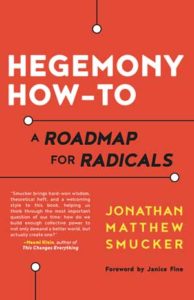Hegemony How-To: A Road Map for Radicals; Against Doom: A Climate Insurgency Manual
Reviewed by Steve Chase
November 1, 2017
Hegemony How-To: A Road Map for Radicals. By Jonathan Matthew Smucker. AK Press, 2017. 280 pages. $16.95/paperback; $16.99/eBook.
Buy from QuakerBooks
Against Doom: A Climate Insurgency Manual. By Jeremy Brecher. PM Press, 2017. 110 pages. $12.95/paperback; $9.99/eBook.
Buy from QuakerBooks
 I am about three decades older than Jonathan Matthew Smucker, but I resonate with his description of the life experience of today’s millennials, as he notes in his book, Hegemony How-To:
I am about three decades older than Jonathan Matthew Smucker, but I resonate with his description of the life experience of today’s millennials, as he notes in his book, Hegemony How-To:
We have entered adulthood to find our nation’s infrastructure crumbling, our government hijacked by a mix of elitist neoliberals and extremist obstructionists, our economic prospects bleak and likely saddled with mountains of debt, our natural world writhing in crisis, our culture’s rampant individualism hollow and unfulfilling, the international scene a hot mess, and our society lacking a collective aspirational horizon.
The choices that we have in this situation, whether we are young or old, can be broken down as follows: (1) turning our backs on basic morality and passively accepting the underlying assumptions of domination, militarism, elitism, and racism in our society; (2) huddling in tiny marginalized radical enclaves denouncing this situation as evil and assuming the role of beautiful and self-righteous losers; or (3) loving our neighbors enough to work with them in effective ways to put forward an alternative vision, build democratic people’s organizations, offer real social leadership, and take strategic action as a growing and powerful majoritarian movement that is genuinely populist, ethical, and committed to the common good.
In his book, Smucker fleshes out this third path beyond either “immoral power” or “powerless morality.” The core argument running throughout the book is that we are not powerless, we are not alone, and there is a large, latent sea of support in the world for positive social change—even if it is often invisible to us. He opens the book with this insight by telling a story of screwing up his courage as a 17-year-old to make a radical economic justice speech at his high school—a speech he thought would earn him nothing but scorn and isolation. Yet, as he reports in surprise, “What I had not anticipated was the number of students who would resonate with the message and would want to find out more” and who “even wanted to do something about the situation.”
Smucker explains the potential of this kind of recruitment in the conclusion of the book:
For every hopeful individual who dives in at the outset, there are many times as many reasonably skeptical sympathizers watching from the sidelines, and not yet convinced that the nascent effort can win; not ready to put the time, energy, and risk into something that is more likely than not to fizzle; or simply not seeing how they might meaningfully plug in to the effort or, all too often, not being provided an appealing opportunity to do so.
Between the beginning and end of the book, Smucker shares many hard-won lessons on how the “initial core of movement participants” can avoid seeing themselves as the whole movement and driving potential movement supporters away through a self-marginalized, hyper moralistic, ultra-radical, insular, and contemptuous approach toward others. The genius of this book is that it helps its readers develop a roadmap for how to inspire, recruit, organize, and mobilize the “unusual suspects” and thus activate “the larger social force that is needed to win the scale of change” we seek.
 Another book that offers a positive and smart take on the challenges we face is Jeremy Brecher’s Against Doom: A Climate Insurgency Manual. It also argues that we can work with our neighbors and engage in effective and strategic action—in this case, to limit catastrophic climate change and transition to a just and climate-safe world.
Another book that offers a positive and smart take on the challenges we face is Jeremy Brecher’s Against Doom: A Climate Insurgency Manual. It also argues that we can work with our neighbors and engage in effective and strategic action—in this case, to limit catastrophic climate change and transition to a just and climate-safe world.
Brecher starts his very first chapter, “This Is What Insurgency Looks Like,” by describing a church-based planning meeting for a nonviolent civil resistance action by residents and supporters of a predominantly low-income, African American neighborhood in Albany, N.Y. As Brecher writes, “They were organizing a protest against trains carrying potentially explosive oil—dubbed by the residents ‘bomb trains’—that were running through their neighborhood.” This action was part of 350.org’s May 2016 “Break Free from Fossil Fuels” civil disobedience campaign that involved hundreds of thousands of people on six continents nonviolently interfering with key elements of the fossil fuels industry in their communities in the space of one week.
The Albany action was not an ultra-leftist affair using a “diversity of tactics,” which is just a term used by self-righteous “radicals” to market feel-good but unstrategic violence. Instead, the action was populist, well-organized, and very disciplined. As Brecher notes, “Participants agreed ‘not to harm people or property;’ to be ‘dignified in dress, demeanor, and language;’ to attend action training; and to act ‘in accordance with the group’s agreed plan for action.’” Their particular action included 1,500 people marching to the train tracks for a spirited celebration of their democratic right to protect their community from harm. Then 500 of them put their bodies on the line to “illegally” blockade the train tracks so no “bomb trains” would pass through their community—or the communities of others.
I put “illegally” in quotes because the participants did not see themselves as criminals. They saw themselves as the people in their community who were willing to defend the law. As Brecher reports, many climate insurgents “have begun to define themselves—to the movement, the public, and the courts—not as criminals, but as law enforcers trying to protect legal rights and halt governments and corporations from committing the greatest crime in human history.”
This is an important reframing because one of the main barriers keeping many “climate worriers” from becoming bold and creative “climate warriors” is their deep-seated self-images as respectable, law abiding citizens who do not engage in improper behavior. If you are like me, you have probably heard many Quakers say, “I could never take part in civil disobedience or risk arrest.” You may have even said it yourself.
Yet what if this version of being “law abiding” is just an unfaithful, inaccurate, and unhelpful way to look at our situation? What if by not taking part in nonviolent civil resistance and just staying passive—or even staying completely locked into the domesticated and rigged “normal channels” of elections, lobbying, and litigation—we are aiding and abetting government and corporate crimes against humanity, the public trust, and the planet?
I wish I had the space to describe in much more depth Brecher’s thoughtful discussions. He describes his view of the public trust doctrine, his vision of a just transition, and the value of building alternative institutions. He spells out his theory of change for a nonviolent global climate insurgency, and how we can involve more people in extended climate insurgency campaigns and increase their effectiveness. He describes how an organized civil resistance movement can effectively undermine the pillars of support for government and corporate climate criminals over time. This occurs when more and more of us follow Gandhi’s path and collectively “withdraw our acquiescence and cooperation from those who are destroying our planet.”
As a Quaker activist and someone who works for the International Center on Nonviolent Conflict, which promotes the study and use of nonviolent civil resistance in social movements, I heartily recommend reading and discussing Brecher’s important new book. Both of these books remind us that there is a world to win and that what we choose to do matters.



Comments on Friendsjournal.org may be used in the Forum of the print magazine and may be edited for length and clarity.